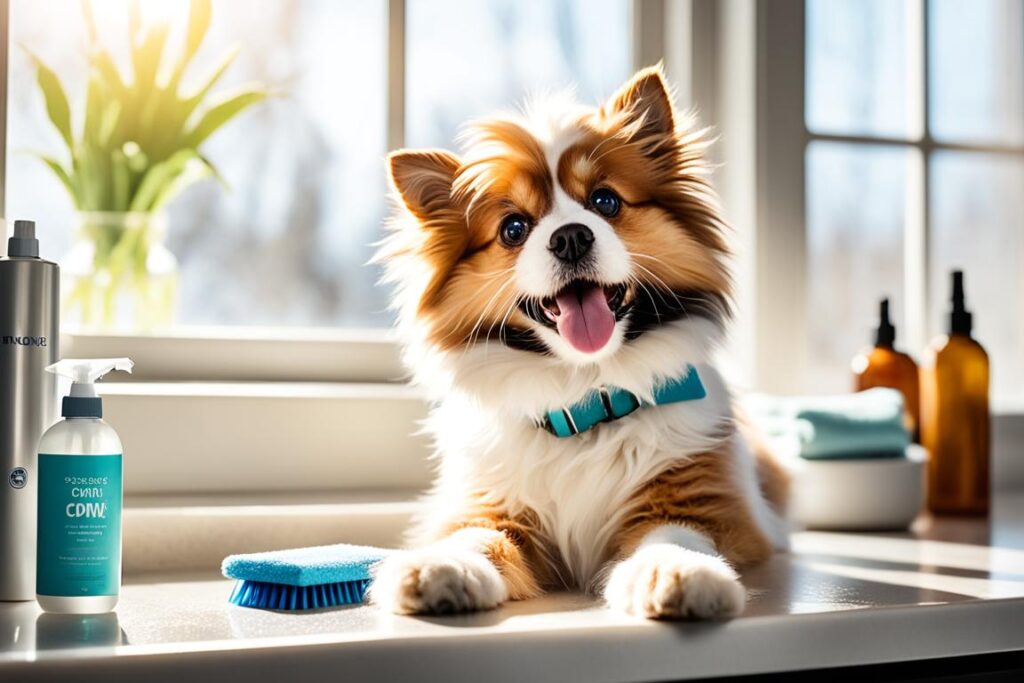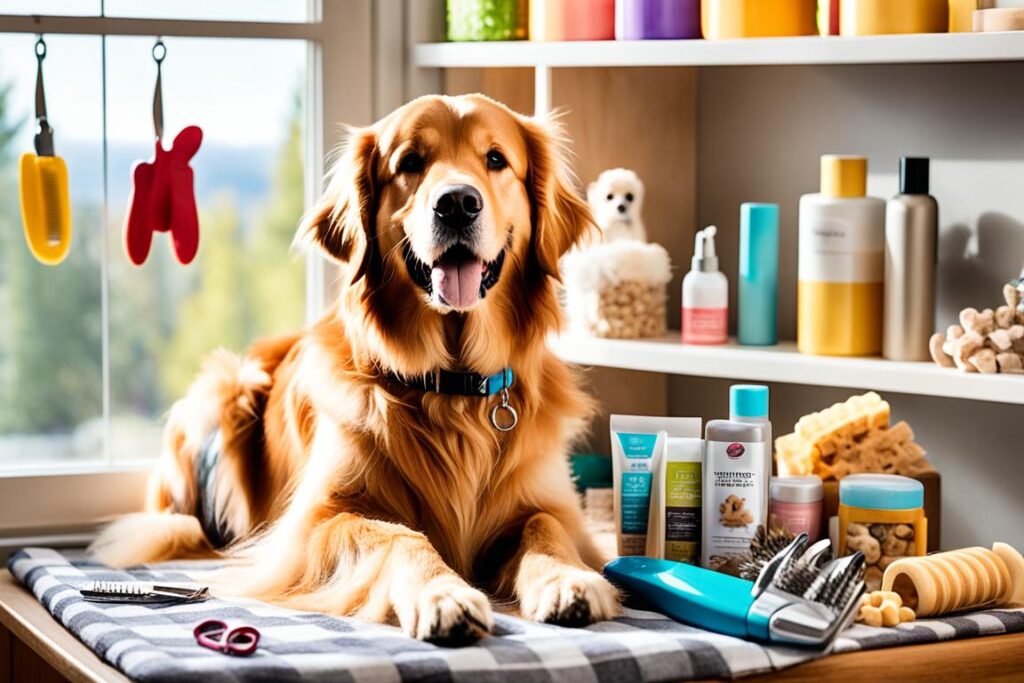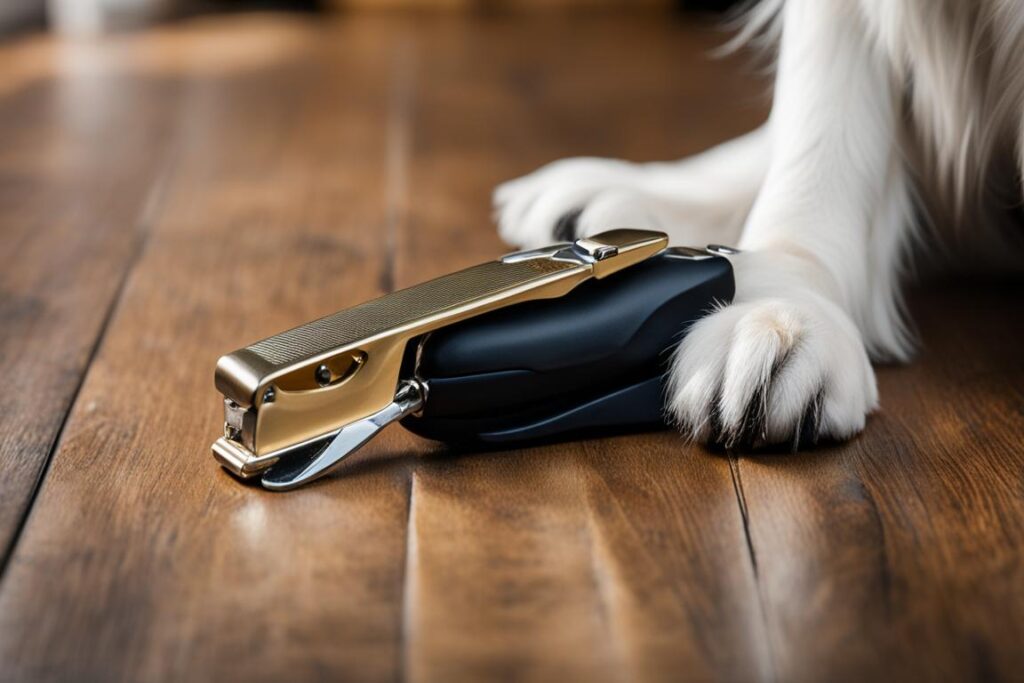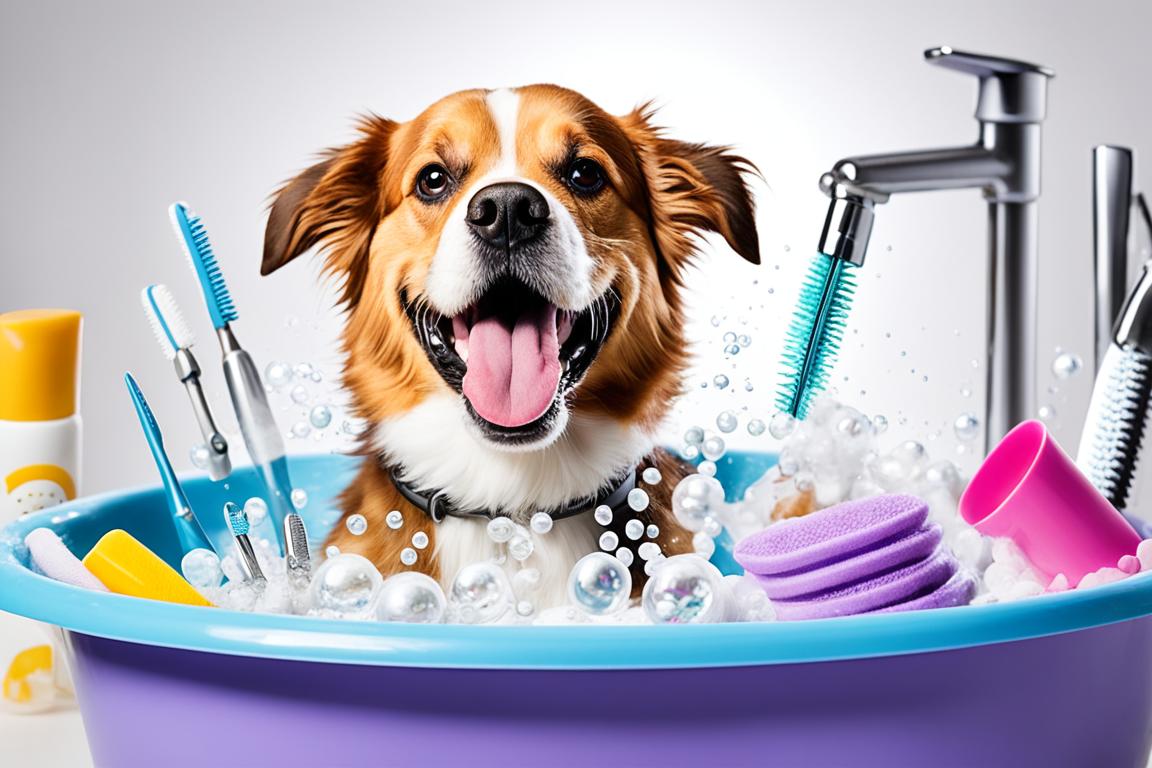Are you looking for ways to keep your furry friend looking their best without breaking the bank? DIY pet grooming techniques are becoming increasingly popular among pet owners. Not only does it save you time and money, but it also allows you to bond with your pet and provide them with a personalized grooming experience. In this article, we will explore the essential tips and techniques for grooming your pet at home, ensuring they have a sleek and healthy coat.
Key Takeaways
- DIY pet grooming techniques offer a cost-effective alternative to professional grooming.
- Grooming your pet at home allows you to bond with them and tailor the experience to their specific needs.
- Proper grooming techniques and tools are essential for maintaining a sleek and healthy coat.
- Understanding your pet’s coat type is crucial for effective grooming.
- Regular brushing, bathing, and nail trimming are key aspects of at-home pet grooming.
Introduction to Home Pet Grooming
In recent years, many pet owners have turned to homemade pet grooming as a convenient and cost-effective solution for keeping their furry friends looking their best. DIY dog grooming and cat grooming techniques have gained popularity due to the numerous benefits they offer. In this section, we will explore the world of home pet grooming and discover how it has become a go-to option for pet owners. We will discuss the advantages of homemade pet grooming, including the opportunity for bonding with your pet and the ability to tailor the grooming experience to fit their specific needs.
Preparing Your Space for DIY Pet Grooming Techniques
Selecting the Right Area
Before you start grooming your pet at home, it’s essential to choose a suitable space where both you and your furry friend will feel comfortable. Find an area that is well-lit and provides enough space for you to move around freely.
Consider the following factors when selecting the right area:
- Choose a quiet and calm space where your pet can relax.
- Ensure the area is easily accessible and has a non-slip surface to prevent accidents.
- Find a spot with good ventilation to avoid any unpleasant odors.
- Keep the area away from distractions, such as other pets or children, to minimize disruptions during the grooming process.
TIP: If you’re grooming a dog, you might want to use a grooming table or elevated surface to make it easier to reach your pet and provide better visibility.
Gathering Necessary Tools
Having the right tools handy is crucial when it comes to DIY pet grooming. Here are some essential tools you should gather before you begin:
- Grooming brush or comb suitable for your pet’s coat type
- Nail clippers or grinder for trimming your pet’s nails
- Ear cleaner and cotton balls for ear cleaning
- Toothbrush and pet-safe toothpaste for dental care
- Shampoo and conditioner formulated for your pet’s specific needs
- Towels and a hairdryer for drying your pet
- Treats and rewards to keep your pet motivated and rewarded during the grooming process
TIP: Remember to regularly clean and disinfect your grooming tools to maintain hygiene and prevent the spread of any infections.
Now that you have prepared your space and gathered the necessary tools, you are ready to embark on your DIY pet grooming journey. In the next section, we will explore how to understand your pet’s coat type and adapt grooming techniques accordingly.
Image:

Understanding Your Pet’s Coat Type
Every pet has a unique coat type, and understanding it is essential for effective grooming. By identifying the different coat textures, you can adapt your grooming methods accordingly, ensuring the best care for your furry friend’s coat. Let’s take a closer look at the various coat textures and how to identify them.
Identifying Different Coat Textures
Coat textures can vary widely among different pets, and it’s important to recognize the specific characteristics of your pet’s coat. Here are some common coat textures you may encounter:
- Short: This coat type is typically smooth and doesn’t require extensive grooming. It is commonly found in breeds such as Dalmatians, Boxers, and Beagles.
- Long: Long coats are characterized by their length and may have a straight or slightly wavy texture. Breeds like Cocker Spaniels, Shih Tzus, and Afghan Hounds often have long coats.
- Curly: Curly coats have tight curls or waves and are more prone to matting. Breeds like Poodles, Bichon Frises, and Portuguese Water Dogs have curly coats.
- Wire-haired: Wire-haired coats have a coarse, bristle-like texture. Breeds such as Terriers, Schnauzers, and Dachshunds often have wire-haired coats.
These are just a few examples of coat textures, and there may be variations within each category. It’s important to closely examine your pet’s coat to determine its specific texture.
Adapting Grooming Methods Accordingly
Once you have identified your pet’s coat type, you can adapt your grooming methods to suit their specific needs. Different coat textures may require different grooming techniques and tools. For example:
- Short coats may benefit from regular brushing to remove loose hairs and maintain a sleek appearance.
- Long coats may require more frequent brushing and occasional trimming to prevent mats and tangles.
- Curly coats may need to be de-matted regularly and require specialized grooming techniques to maintain their curls.
- Wire-haired coats may need stripping to remove dead hair and maintain their unique texture.
Adapting your grooming methods according to your pet’s coat type ensures that you are providing the most effective care and keeping their coat in optimal condition.
| Coat Type | Texture | Examples |
|---|---|---|
| Short | Smooth | Dalmatians, Boxers, Beagles |
| Long | Straight or slightly wavy | Cocker Spaniels, Shih Tzus, Afghan Hounds |
| Curly | Tight curls or waves | Poodles, Bichon Frises, Portuguese Water Dogs |
| Wire-haired | Coarse, bristle-like | Terriers, Schnauzers, Dachshunds |
DIY Dog Grooming Essentials
Dogs require regular grooming to keep their coat healthy and manageable. In this section, we will cover the essential grooming techniques and tools specifically for dogs. From brushing to nail trimming, you will learn everything you need to know to maintain your dog’s well-groomed appearance.
When it comes to DIY dog grooming, there are a few key techniques that every dog owner should be familiar with.
- Brushing: Regular brushing helps to remove loose hair, prevent matting, and distribute natural oils throughout your dog’s coat. Use a brush suitable for your dog’s coat type, such as a slicker brush for long-haired breeds or a bristle brush for short-haired breeds.
- Nail Trimming: Keeping your dog’s nails trimmed is important for their comfort and mobility. Use a pair of dog nail clippers or a nail grinder designed specifically for pets. Be careful not to cut the quick, which is the sensitive part of the nail that contains blood vessels and nerves.
- Ear Cleaning: Regularly cleaning your dog’s ears can help prevent infections. Use a gentle ear cleaner specifically formulated for dogs and avoid inserting anything deep into the ear canal.
- Bathing: Bathing your dog helps to keep their coat clean and free from dirt and odors. Use a dog-friendly shampoo and make sure to rinse thoroughly to avoid any residue.
- Grooming Tools: Investing in the right grooming tools can make the process easier and more efficient. Some essential tools include a slicker brush, a comb, nail clippers or a grinder, ear cleaner, and dog-friendly shampoo.
By incorporating these DIY dog grooming techniques into your regular routine and using the appropriate pet grooming tools, you can ensure that your furry friend always looks and feels their best.

Bathing Your Pet: A Step-by-Step Guide
Choosing the Right Shampoo
When it comes to bathing your pet, selecting the right shampoo is crucial. Different pets have different needs, so it’s essential to choose a shampoo that caters to their specific requirements. For example, if your pet has sensitive skin, look for a hypoallergenic shampoo. If your pet has fleas or ticks, opt for a medicated shampoo that can help combat these pesky parasites.
Remember, never use human shampoo on your pet as it can be too harsh and may cause skin irritation. Always use a shampoo specifically formulated for pets.
Bathing Techniques for Different Pets
Every pet is unique, and their bathing needs may vary. Here are some bathing techniques to keep in mind for different types of pets:
- Dogs: Before bathing your dog, give them a thorough brush to remove any tangles or mats. Use lukewarm water and wet your dog’s coat thoroughly. Apply the chosen shampoo, lather it gently, and massage it into their coat. Rinse thoroughly and dry them using a towel or blow dryer on a low heat setting.
- Cats: Cats are generally self-grooming animals, and bathing may not be necessary unless they have specific coat or skin issues. If you need to bathe your cat, ensure they are comfortable and calm. Use a gentle cat-specific shampoo, lather it gently, and rinse thoroughly. To make the experience less stressful, consider using a sink or basin instead of a bathtub.
- Small Pets: For small pets such as rabbits or guinea pigs, it’s best to avoid full baths as they may find it distressing. Instead, use a damp cloth or pet wipes to clean their fur and remove any dirt or debris. Be sure to check with your veterinarian for specific bathing instructions for your small pet.
Remember, always reward your pet with praise and treats after a successful bathing session to make it a positive experience for them.
Brushing and Combing Techniques for a Glossy Coat
Regular brushing and combing are crucial for maintaining a glossy coat and preventing mats and tangles. By incorporating these grooming techniques into your pet’s routine, you can keep their fur healthy and lustrous. Here, we will explore different brushing and combing techniques that you can use to maintain your pet’s coat and discuss the best grooming tools for the job.
When it comes to brushing your pet, it’s important to consider their specific coat type. Short-haired pets generally require less frequent brushing, while long-haired breeds may need daily brushing to prevent matting. Use a slicker brush or bristle brush to remove loose hair and distribute natural oils throughout your pet’s coat, promoting a healthy shine.
If your pet has a thick, double coat, such as the fur of Siberian Huskies or Golden Retrievers, using an undercoat rake can help remove dead hair and reduce shedding. This type of comb reaches through the topcoat and removes loose hair from the undercoat, preventing it from matting or causing discomfort to your pet.
For pets with curly or wiry hair, such as Poodles or Scottish Terriers, a slicker brush or comb with wide-spaced teeth can effectively detangle their fur and prevent matting. Gently work through the hair in sections, starting at the ends and working your way up to the roots.
When combing your pet’s hair, use a wide-toothed comb or a dematting tool to remove tangles and prevent them from tightening into mats. Begin at the ends of the hair and slowly work your way up while holding the hair above the tangle to ease any discomfort or pulling. Regular combing can help prevent painful matting and promote a sleek and manageable coat.
Remember to be gentle and patient when brushing and combing your pet’s hair. Use treats and positive reinforcement to create a positive grooming experience for them. Additionally, be mindful of sensitive areas like ears, tail, and belly, where tangles and mats are more likely to occur.
Investing in high-quality grooming tools is essential for effective brushing and combing. Look for brushes and combs made from durable materials with comfortable handles for easy grip. Choose tools that suit your pet’s coat type and size for optimal results.
In conclusion, regular brushing and combing are key to maintaining a glossy coat and preventing mats and tangles in your pet’s fur. By using the proper techniques and investing in quality grooming tools, you can ensure that your furry friend’s coat remains healthy, shiny, and free of tangles. Happy grooming!
Maintaining Nail Health with Regular Trims
Nail health is often overlooked in pet grooming, but it is essential for their overall well-being. Just like humans, pets need regular nail care to prevent discomfort and potential health issues. In this section, we will discuss the importance of pet nail trimming and provide valuable tips for safe and effective nail care at home.
Identifying the Quick
Before you start trimming your pet’s nails, it’s crucial to identify the quick, the sensitive part of the nail that contains blood vessels and nerves. Cutting into the quick can cause pain and bleeding. It’s recommended to have a styptic powder or cornstarch on hand to stop any bleeding if you accidentally trim the quick.

When trimming dark-colored nails, where the quick is not visible, it’s best to trim a small amount at a time to avoid cutting too close. Observe your pet’s reaction and stop immediately if they show signs of distress or discomfort.
Nail Trimming Tools
There are several nail trimming tools available for at-home use, including:
| Tool | Description |
|---|---|
| Nail clippers | These are specially designed clippers for trimming pet nails. Choose clippers that are appropriate for the size of your pet. |
| Nail grinders | These electric or battery-operated tools grind down the nail gradually. They can be helpful for pets with thick or hard nails. |
| Nail files | Files with a fine-grit surface can be used to smoothen any rough edges after trimming. |
When choosing nail trimming tools, opt for high-quality, pet-specific tools to ensure precision and safety. It’s also essential to keep the tools clean and sharp for optimal performance. Regular maintenance of the tools will prolong their lifespan and prevent any discomfort during the nail trimming process.
By regularly maintaining your pet’s nail health through careful trimming and using appropriate tools, you can prevent discomfort, ensure their overall well-being, and mitigate the risk of injuries or infections caused by overgrown nails.
Cat Grooming Techniques: Beyond the Bath
Cats have unique grooming needs that go beyond just bathing. In addition to regular baths, it’s important to pay attention to their claws and brushing routine to keep their coat healthy and beautiful.
Dealing with Claws
Trimming your cat’s claws is an essential part of their grooming routine. Not only does it help prevent scratching-related accidents, but it also keeps their claws in a manageable condition.
To trim your cat’s claws:
- Gently hold your cat’s paw and press the pad to extend the claws.
- Using cat-specific nail clippers, trim the pointed tip of each claw, taking care not to cut too close to the quick (the pink portion inside the claw).
- If your cat is not comfortable with nail trims, consider seeking the assistance of a professional groomer or veterinarian.
Feline-Friendly Brushing Tips
Regular brushing is crucial for keeping your cat’s coat tangle-free and reducing hairballs. Here are some tips to make the brushing experience more enjoyable for your feline friend:
- Choose a brush or comb suitable for your cat’s coat type. Short-haired cats may benefit from a soft-bristle brush, while long-haired cats may require a wider-toothed comb.
- Start by gently stroking your cat with the brush or comb to familiarize them with the sensation.
- Brush your cat’s fur in the direction of hair growth, using slow and gentle strokes.
- If you encounter any tangles or mats, carefully work through them using your fingers or a dematting tool.
- Make sure to reward your cat with treats or praise after each successful brushing session to reinforce positive associations.
By incorporating these cat grooming techniques into your routine, you can ensure that your furry companion stays comfortable, healthy, and well-groomed.
Home Pet Grooming Instructions: Ear and Dental Care
Proper ear and dental care are crucial for your pet’s overall health. In this section, we will provide step-by-step instructions for safely cleaning your pet’s ears at home and tips for maintaining their dental hygiene. By following these guidelines, you can ensure that your furry friend’s ears and teeth stay clean and healthy, preventing common issues such as infections and dental disease.
Cleaning Ears Safely
Regular ear cleaning is essential to prevent ear infections and discomfort for your pet. Here’s a simple step-by-step guide to safely clean your pet’s ears:
- Gather the necessary supplies, such as a vet-approved ear cleaning solution and cotton balls.
- Hold your pet gently but firmly to keep them still during the process.
- Squeeze a small amount of the ear cleaning solution into your pet’s ear canal.
- Gently massage the base of the ear to distribute the solution and loosen any dirt or debris.
- Use a cotton ball to wipe away the loosened dirt and excess solution from the outer ear.
- Repeat these steps on the other ear, if necessary.
Remember, if you notice any signs of redness, swelling, or discharge in your pet’s ears, consult your veterinarian for further evaluation.
Dental Hygiene for Pets
Just like humans, pets can develop dental problems that can affect their overall health. Here are some tips to maintain your pet’s dental hygiene:
- Brush your pet’s teeth regularly using a soft-bristled toothbrush and veterinarian-approved toothpaste. Start gradually and make it a positive experience for your pet.
- Provide dental chews and toys specifically designed to promote dental health, helping to reduce plaque and tartar buildup.
- Include dental-friendly treats in your pet’s diet that can help clean their teeth as they chew.
- Schedule regular dental check-ups with your veterinarian to monitor your pet’s oral health.
By implementing these dental care practices, you can help prevent dental disease and keep your pet’s teeth strong and healthy.
Conclusion
In conclusion, DIY pet grooming offers numerous benefits for both you and your furry friend. Throughout this article, we have discussed the essential tips and techniques to help you maintain a sleek and healthy coat for your pet at home. By following these DIY grooming methods, you can save time and money while strengthening the bond with your pet.
Remember, selecting the right area and gathering the necessary tools are crucial for a successful grooming session. Understanding your pet’s unique coat type and adapting grooming methods accordingly will ensure effective results. For dogs, regular brushing, bathing, and nail trimming are essential for their overall well-being.
Additionally, we have explored specific techniques for grooming cats, such as dealing with claws and brushing tips. Don’t forget to prioritize ear and dental care for your pet’s health, and we have provided step-by-step instructions to safely clean their ears and maintain dental hygiene.
With the knowledge gained from this article, you can confidently groom your pet at home. Make use of the DIY pet grooming techniques and final tips outlined here to keep your furry friend looking their best. Take pride in your ability to provide professional-quality grooming in the comfort of your own home, ensuring a sleek and healthy coat for your beloved pet.
FAQ
What are some DIY pet grooming techniques?
DIY pet grooming techniques include brushing and combing, nail trimming, bathing, and maintaining ear and dental hygiene.
Why is pet grooming at home becoming increasingly popular?
Pet grooming at home allows pet owners to bond with their pets and customize the grooming experience to suit their pets’ needs.
How can I create a suitable space for grooming my pet at home?
To create a suitable space for grooming your pet at home, select an area with good lighting and ventilation, ideally a well-lit bathroom or utility room. Ensure you have a non-slip surface and all necessary grooming tools within reach.
What tools do I need for pet grooming at home?
Essential tools for pet grooming at home include a brush or comb suitable for your pet’s coat type, nail clippers or a nail grinder, pet-friendly shampoo, toothbrush and toothpaste, and ear cleaning solution.
How can I identify my pet’s coat type?
Different coat textures include short, long, curly, wiry, and double-coated. You can identify your pet’s coat type by observing the texture and length of their fur.
How do I adapt grooming methods according to my pet’s coat type?
For short coats, use a rubber curry brush. For long coats, use a slicker brush and comb. Curly and wiry coats may require specialized brushes or tools. Double-coated breeds need regular brushing with an undercoat rake.
What are some essential grooming techniques and tools for dogs?
Essential grooming techniques for dogs include brushing, bathing, nail trimming, and ear and dental care. Tools such as slicker brushes, grooming shears, and toothbrushes are commonly used.
How do I bathe my pet at home?
Choose a pet-friendly shampoo and ensure the water temperature is comfortable for your pet. Wet your pet thoroughly and lather the shampoo, then rinse well. Towel dry or use a blow dryer on a low, cool setting if your pet is comfortable with it.
What brushing and combing techniques are best for maintaining a glossy coat?
Use a slicker brush or bristle brush for regular brushing. Comb through the fur to ensure there are no tangles or mats. Pay extra attention to sensitive areas such as the underarms and behind the ears.
How do I safely trim my pet’s nails?
Identify the quick in your pet’s nails (the sensitive part) and trim just below it to avoid causing pain or bleeding. Use nail clippers or a nail grinder specifically designed for pets. Take breaks if your pet gets restless or stressed.
How can I groom my cat beyond just bathing?
To groom your cat, trim their claws regularly and provide a scratching post for them to use. Use a soft brush or grooming mitt to brush their coat and remove loose fur.
How do I clean my pet’s ears and maintain their dental hygiene?
Use a damp cotton ball or soft cloth to clean the outer part of your pet’s ears. For dental hygiene, brush your pet’s teeth regularly with a pet-safe toothbrush and toothpaste. Avoid using human toothpaste, as it can be toxic to pets.
What are some additional tips for successful DIY pet grooming?
Use positive reinforcement and treats to make grooming a pleasant experience for your pet. Take your time and be gentle. If your pet becomes stressed or anxious, take a break and try again later. Seek professional help if you are unsure or uncomfortable with any aspect of grooming.

